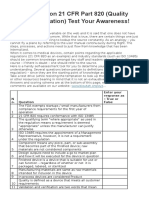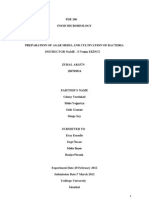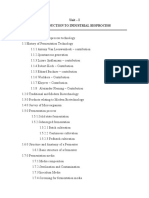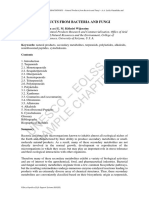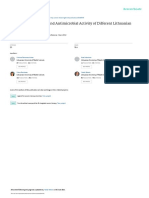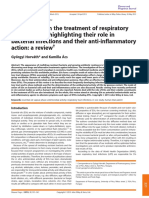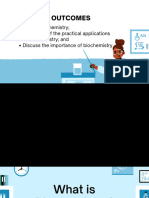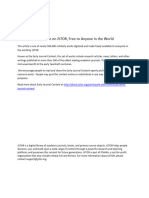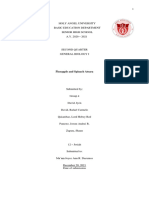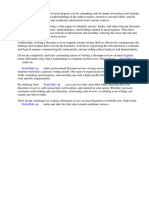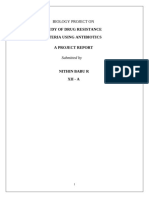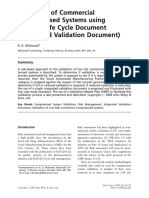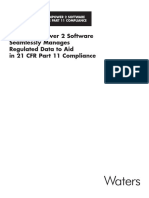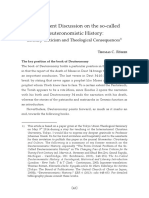0 ratings0% found this document useful (0 votes)
51 viewsPyrogens - Prof. J. Vijaya Ratna Jayanti
Pyrogens - Prof. J. Vijaya Ratna Jayanti
Uploaded by
Nitin KashyapPyrogens are fever-producing substances that are metabolic byproducts of microorganisms. The most potent and significant pyrogens are endotoxins produced by gram-negative bacteria cell walls. Pyrogens cause physiological changes like fever if injected into patients, so it is important that parenteral products are tested to ensure they are apyrogenic, or lack pyrogens. The nature and omnipresence of bacterial endotoxins, the most significant pyrogens, make them difficult to remove from products, equipment, and environments.
Copyright:
© All Rights Reserved
Available Formats
Download as DOCX, PDF, TXT or read online from Scribd
Pyrogens - Prof. J. Vijaya Ratna Jayanti
Pyrogens - Prof. J. Vijaya Ratna Jayanti
Uploaded by
Nitin Kashyap0 ratings0% found this document useful (0 votes)
51 views4 pagesPyrogens are fever-producing substances that are metabolic byproducts of microorganisms. The most potent and significant pyrogens are endotoxins produced by gram-negative bacteria cell walls. Pyrogens cause physiological changes like fever if injected into patients, so it is important that parenteral products are tested to ensure they are apyrogenic, or lack pyrogens. The nature and omnipresence of bacterial endotoxins, the most significant pyrogens, make them difficult to remove from products, equipment, and environments.
Original Description:
pyr
Original Title
Pyro Gens
Copyright
© © All Rights Reserved
Available Formats
DOCX, PDF, TXT or read online from Scribd
Share this document
Did you find this document useful?
Is this content inappropriate?
Pyrogens are fever-producing substances that are metabolic byproducts of microorganisms. The most potent and significant pyrogens are endotoxins produced by gram-negative bacteria cell walls. Pyrogens cause physiological changes like fever if injected into patients, so it is important that parenteral products are tested to ensure they are apyrogenic, or lack pyrogens. The nature and omnipresence of bacterial endotoxins, the most significant pyrogens, make them difficult to remove from products, equipment, and environments.
Copyright:
© All Rights Reserved
Available Formats
Download as DOCX, PDF, TXT or read online from Scribd
Download as docx, pdf, or txt
0 ratings0% found this document useful (0 votes)
51 views4 pagesPyrogens - Prof. J. Vijaya Ratna Jayanti
Pyrogens - Prof. J. Vijaya Ratna Jayanti
Uploaded by
Nitin KashyapPyrogens are fever-producing substances that are metabolic byproducts of microorganisms. The most potent and significant pyrogens are endotoxins produced by gram-negative bacteria cell walls. Pyrogens cause physiological changes like fever if injected into patients, so it is important that parenteral products are tested to ensure they are apyrogenic, or lack pyrogens. The nature and omnipresence of bacterial endotoxins, the most significant pyrogens, make them difficult to remove from products, equipment, and environments.
Copyright:
© All Rights Reserved
Available Formats
Download as DOCX, PDF, TXT or read online from Scribd
Download as docx, pdf, or txt
You are on page 1of 4
Pyrogens - Prof. J.
Vijaya Ratna Jayanti
For the parenteral products, the most usual vehicle is water. Water is most abundantly
available, cheap, safe, non-toxic and non-irritating. But anything that is to be
administered parenterally has to be sterile and apyrogenic. Apyrogenesity means lack
of pyrogens. Pyrogens are the metabolic products of bacteria. In making a vehicle
suitable for parenteral preparation, we may sterilize it by autoclaving, which would kill
the vegetative organisms as well as the spores. But the water once had organisms
living in it and their metabolic products now stay in the water. These products are not
destroyed by autoclaving. Since they cannot be destroyed at the usual autoclaving
temperature, they must be prevented from getting into water. So the water being
taken for parenteral preparation must be apyrogenic.
Pyrogens can cause a lot of damage, if they are injected into a human being. Hence
every batch of injections is tested for the presence of pyrogens. The word "pyrogens"
means, "fever producing".
What is the Definition of Pyrogen?
Pyrogens are fever producing substances, which are metabolic products of
microorganisms. Chemically, they are lipid substances associated with a carrier
molecule, which is usually a polysaccharide. The carrier may also be a peptide. These
carriers increase the solubility of the lipid. Pyrogens are produced by many
microorganisms including bacteria, yeasts and moulds. Most potent pyrogens are the
endotoxins produced from the cell walls of the Gram- negative bacteria. Pyrogens have
a high molecular weight, often, more than 1,000,000. 1
What is the source of Pyrogen?
Sources of Pyrogens: Solvents, drugs, additives apparatus used in manufacture,
containers; all or any of these may be sources of pyrogens. The method of storage in
between preparation and sterilization also may cause the development of pyrogens.
Hence every item must be apyrogenic and method of storage must not allow any
bacterial growth.
What PYROGENS do?
If unintentionally, pyrogens are injected into a patient, they may bring about the
following physiological changes:
Erythema at the injection site
Pain in the legs and trunk
General discomfort
High temperature
Pyrogens, if present in large volume parenterals, can be especially dangerous, as they
would be present in large quantities and are given intravenously. Pyrogens in large
volume parenterals may make the patients very ill and the effect of rise of
temperature may be fatal. Hence there is a need for testing parenteral solutions for
their apyrogenesity and Pharmacopeias make it compulsory.
What is the history of Pyrogens?
In the years gone by, there was only one way in which pyrogens were tested for, i.e.,
by the Rabbits' test. But today much easier methods such as the limulus amoebocyte
lysate test are available for testing for pyrogens. If we look at the history of pyrogens,
we find that since the time of introduction of intravenous therapy, in 1656, by Sir
Christopher Wren, the awareness of a fever producing agent was there. The
documented research into the development of medicines contains many references to
episodes of fever following intravenous infusions. But the scientists could not find the
mechanism by which intravenous therapy was producing fever. Since fever frequently
followed sepsis in wounds, physicians thought that the tissues in the wounds were
decomposing, then putrefying by fermentation and in the process were causing the
fever. Louis Pasteur (1822-1895), discovered that bacteria caused fermentation. Then
scientists associated fever and pyrogens with fermentation and with bacteria. But they
had no idea about the origin of pyrogens, whether they were produced by bacteria or
whether they were a part of bacteria.
Research into the nature of pyrogens started showing good results in 1894, when
Centanni extracted pyrogens from many types of bacteria. He extracted pyrogens from
Esherichia coli too. Scientists started looking into the chemical and physiological
nature of pyrogens. Centanni showed that pyrogens were not proteinous and that they
were not susceptible to heat. It was the publications of Hort and Penfold, in the year
1912, that provided the best understanding of the nature of pyrogens. They started
the Rabbit Assay and standardized it for fever. By correlating the fever effect in rabbits
with the extent of pyrogens, and by characterizing the bacteria by staining as Gram
positive and Gram negative Hort and Penfold could prove that the pyrogenic bacteria
were predominantly Gram negative whereas the Gram positive were mostly
apyrogenic. Then they could correlate between the bacterial count in the injected
distilled water and the extent of fever caused and also prove that dead bacteria also
caused fever. Then, Hort and Penfold, concluded that the real cause of injection fevers
was a filterable substance which was stable to heat, and was produced by bacteria.
Seibert's investigations in the years1923-1925, proved these findings conclusively.
Seibert could also develop a process for the production of apyrogenic infusion fluids.
Hospital pharmacists were very happy to follow the method introduced by Siebert to
produce large volume parenterals that were very safe for use in patients. Seibert's
methods also launched the large commercial LVP solutions industry. Today's huge LVP
production industry depends on the availability of large volumes of sterile and
apyrogenic water which is produced by distillation.
Sponsored Links
A typical production procedure for manufacture of injectables goes like this:
Apyrogenic raw materials are dissolved in apyrogenic water for injection. Mixing is
done in depyrogenated tanks. The prepared solution is dispensed into depyrogenated
containers. These containers are immediately autoclaved in order to prevent the
growth of any microorganisms that might be present in the solution.
What is the Nature of Pyrogens?
A pyrogen is a fever producing substance. The most important pyrogen is the
endotoxin produced by the Gram negative bacteria. Some pyrogens are there, which
are not of microbial origin. They are in fact pharmacological agents, such as bleomycin
and colchicines. But it is the microbial pyrogens that pose a problem to the
manufacturers. While many organisms including live and dead bacteria, fungi, viruses,
malarial parasites, and the bacterial products such as streptococcal exotoxins,
staphylococcal enterotoxin, bacterial endotoxin lipopolysaccharide, and fungal
products can act as pyrogens, it is the Gram negative bacteria produced endotoxin
that is the most significant pyrogen for the manufacturers of injectables. This
endotoxin is the most significant because its lipopolysaccharide component is very
toxic in very small quantities. A quantity as small as 1ng/kg of the USP Reference
endotoxin can cause fever.
Fever inducing mechanism:
Endotoxin pyrogen enters the bloodstream.
It binds to Lipopolysaccharide (LPS) binding protein (LPB). LPB takes it to the
reticuloendothelial system (RES). The receptor cells in the RES are the circulating
mononuclear
cells.
This attachment to the receptor cells causes the production of proinflammatory
cytokines.
These cytokines are interleukin-1 (IL-1), interleukin-6 (IL-6), and tumor necrosis factora
(TNFa).
These factors produce inflammation and fever.
Nature of Bacterial Endotoxin: This endotoxin is present almost everywhere and is very
difficult to remove. Its nature and omnipresence is as following:
This is a high molecular weight complex molecule. This comes from the outer cell wall
membrane of gram negative bacteria. These GNB keep shedding the endotoxin into
the
environment
in
which
live.
The endotoxin is shed by the bacteria as they live, as they multiply and also after they
die and disintegrate.
So endotoxin may be present in a system in a form associated with live organisms or
unassociated, in a free manner. Endotoxin associated with microorganisms may be
removed by microporous sterilizing filters. But unassociated endotoxin passes through
these filters also. It cannot be destroyed by autoclaving as it is heat stable. Endotoxin
can be found in food materials, in ground waters, in soil and in substances. It is found
on
laboratory
glassware,
research
apparatus,
and
water
baths.
It can be found in all places where moisture may be there.
Chemical Nature of endotoxin: Bacterial endotoxins contain lipid, protein and
carbohydrate.
The primary chemical structure is a polysaccharide structure which is covalently bound
to a lipid, called lipid A. Because of this structure, the bacterial endotoxin is called as
lipopolysccharide
or
LPS.
The lipid A part is in the bacterial cell wall. The polysaccharide projects into the
environment.
The polysaccharide consists of two parts; a core oligosaccharide which is connected to
Lipid A and a longer oligosaccharide O- specific chain which is attached to the core.
This second oligosaccharide O- specific chain is the variable part of the molecular
structure. The minimum variable component is the lipid A. Lipid A consists of a
disaccharide of glucosamine. The glucosamine is highly substituted with ester linked
and amide linked long chain fatty acids. Each fatty acid has a backbone of 14 carbon
atoms. Lipid A is responsible for the harmful and useful activities of endotoxin.
References:
1. The Theory and Practice of industrial Pharmacy, Leon Lachman and Herbert A.
Lieberman, Special Indian Edition, 2009, CBS Publishers and distributors, page 641.
2. James Swarbrick, Encyclopedia of Pharmaceutical Technology, Volume 1,Third
edition, , Informa Health care, Newyork: 2007: pages 3052- 3053
You might also like
- 21 Questions On 21 CFR Part 820Document2 pages21 Questions On 21 CFR Part 820Nitin KashyapNo ratings yet
- Experiment 1 - Preparing Nutrient AgarDocument9 pagesExperiment 1 - Preparing Nutrient AgarZuhal AkgunNo ratings yet
- FDA and Industry Collaboration On Computer Software AssuranceDocument56 pagesFDA and Industry Collaboration On Computer Software AssuranceNitin Kashyap100% (5)
- V Model - GampDocument2 pagesV Model - GampNitin Kashyap100% (1)
- Iq/Oq: Iq/Oq For Vaisala Viewlinc Monitoring System Page 1 of 161Document23 pagesIq/Oq: Iq/Oq For Vaisala Viewlinc Monitoring System Page 1 of 161Nitin KashyapNo ratings yet
- Soap NotesDocument4 pagesSoap NotesLatora Gardner Boswell100% (3)
- A Dictionary of Jewish Babylonian AramaicDocument26 pagesA Dictionary of Jewish Babylonian Aramaicsedra12No ratings yet
- SR PolarDocument1 pageSR PolaramritrathNo ratings yet
- Approximating The Shapiro-Wilk W-Test For Non-NormalityDocument3 pagesApproximating The Shapiro-Wilk W-Test For Non-NormalityOsman HamdiNo ratings yet
- Microorganisms Friend and FoeDocument5 pagesMicroorganisms Friend and Foesidhantm823No ratings yet
- Expt 11 Lab ReportDocument11 pagesExpt 11 Lab ReportGracechel PormildaNo ratings yet
- 01 Overview On BiochemistryDocument56 pages01 Overview On Biochemistryespinuevajelaica7No ratings yet
- LegionellaDocument40 pagesLegionellaniluh suwasantiNo ratings yet
- Assessing Non-Endotoxin Microbial Pyrogens in Relation in Pharmaceutical ProcessingDocument5 pagesAssessing Non-Endotoxin Microbial Pyrogens in Relation in Pharmaceutical ProcessingDr D RoyNo ratings yet
- Sterility Testing, Pyrogens, and Pyrogen Testing: Kinds of MediaDocument6 pagesSterility Testing, Pyrogens, and Pyrogen Testing: Kinds of MediaApril Mergelle LapuzNo ratings yet
- Basic Industrial BiotechnologyDocument29 pagesBasic Industrial BiotechnologyBharathiNo ratings yet
- Journal La Lifesci: The Effect of Environmental Factors On Microbial GrowthDocument6 pagesJournal La Lifesci: The Effect of Environmental Factors On Microbial Growthpande astri utamiNo ratings yet
- Natural Products From Bacteria and FungiDocument10 pagesNatural Products From Bacteria and FungiCat MeowNo ratings yet
- Food Spoilage and Detection - 3Document77 pagesFood Spoilage and Detection - 3Dileep K CNo ratings yet
- Introduction To MicrobiologyDocument52 pagesIntroduction To MicrobiologyHoward Barlomento100% (3)
- Bacterial Endotoxin Test by Gel Clot MethodDocument4 pagesBacterial Endotoxin Test by Gel Clot MethodEditor IJTSRD100% (1)
- UntitledDocument48 pagesUntitledAlexander LeaNo ratings yet
- Antimicrobial Properties of Molave Leaves Extract Against E.coli BacteriaDocument23 pagesAntimicrobial Properties of Molave Leaves Extract Against E.coli BacteriaDaniel Peralta100% (1)
- Psychrophilic Microorganisms: Habitats and Exploitation PotentialsDocument9 pagesPsychrophilic Microorganisms: Habitats and Exploitation PotentialsEvelyn Gisela Lopez PinoNo ratings yet
- Mycoplasma EnglishDocument10 pagesMycoplasma EnglishAna Maria ParedesNo ratings yet
- Microbiology 1Document26 pagesMicrobiology 1FESTUS MAKINYA NCHOGANo ratings yet
- CO2 IncubatorDocument1 pageCO2 IncubatorabmopalhvacNo ratings yet
- Micropara HomeworkDocument4 pagesMicropara HomeworkCzarina Mae Quinones TadeoNo ratings yet
- Unit 1 Ticket To ClassDocument14 pagesUnit 1 Ticket To ClasslaynesellarsNo ratings yet
- Total Phenolic Content and Antimicrobial ActivityDocument6 pagesTotal Phenolic Content and Antimicrobial ActivityŞule Kalmış MiktatoğluNo ratings yet
- 3 Sawyer ISO 2018Document28 pages3 Sawyer ISO 2018MamdouhNo ratings yet
- Methods of Endotoxin Removal From Biological PreparationsDocument17 pagesMethods of Endotoxin Removal From Biological PreparationsexecNo ratings yet
- Food Borne Disease Presentation FinalDocument25 pagesFood Borne Disease Presentation FinalSagar WaghmareNo ratings yet
- C5 - The Microbiology of Food PreservationDocument57 pagesC5 - The Microbiology of Food PreservationPaula MorisNo ratings yet
- Bio Preservatives in Meat and Meat ProductsDocument42 pagesBio Preservatives in Meat and Meat Productsjaiemailbackup100% (1)
- Essential Oils in The Treatment of Respiratory Tract Diseases Highlighting Their Role in Bacterial Infections and Their Anti-Inflammatory Action: A ReviewDocument11 pagesEssential Oils in The Treatment of Respiratory Tract Diseases Highlighting Their Role in Bacterial Infections and Their Anti-Inflammatory Action: A ReviewAri100% (2)
- Sterilization and DisinfectionDocument5 pagesSterilization and DisinfectionJuvinch R. VicenteNo ratings yet
- Chapter 1 Intro To BiochemistryDocument22 pagesChapter 1 Intro To BiochemistryalfilerrheamaeNo ratings yet
- 01 Introduction To MicrobiologyDocument46 pages01 Introduction To MicrobiologyAnabel ManggagaNo ratings yet
- Biology Investigatory Project: The Study of Effects of Antibiotics On Micro-OrganismsDocument9 pagesBiology Investigatory Project: The Study of Effects of Antibiotics On Micro-OrganismsSamanwitha SharmaNo ratings yet
- 2013 Supplement History of Medical MicrobiologyDocument6 pages2013 Supplement History of Medical MicrobiologyjordanleilaNo ratings yet
- Free Tool - Food Safety QuizDocument2 pagesFree Tool - Food Safety Quiz8tvp8n2yvxNo ratings yet
- Noninvasive Technique - Safety, and Security - Gorachand Dutta - 7Document34 pagesNoninvasive Technique - Safety, and Security - Gorachand Dutta - 7AnjanaNo ratings yet
- Early JournalDocument9 pagesEarly JournalLeonardo GutierrezNo ratings yet
- 376 - Marine Sponges As PharmacyDocument21 pages376 - Marine Sponges As PharmacyshemishamzNo ratings yet
- Microbio ScientistDocument8 pagesMicrobio ScientistTrisha CabreraNo ratings yet
- Literature Review On Bacterial GrowthDocument5 pagesLiterature Review On Bacterial Growthafmzzgeqdsedez100% (1)
- Abag, Mary Eisle E. Acosta, Charrisma A. Beron, Danica D. Camsol, Kristina CDocument55 pagesAbag, Mary Eisle E. Acosta, Charrisma A. Beron, Danica D. Camsol, Kristina CRen H. RoxasNo ratings yet
- Biology Investigatory ProjectDocument6 pagesBiology Investigatory ProjectPritam Meena60% (5)
- Antimicrobial Activity of Plectranthus Amboinicus (Lour.) Against Gram Negative Bacteria Klebsiella Phytochemical TestsDocument8 pagesAntimicrobial Activity of Plectranthus Amboinicus (Lour.) Against Gram Negative Bacteria Klebsiella Phytochemical TestsDung NguyenNo ratings yet
- GenBio - Performance Task - Group4Document12 pagesGenBio - Performance Task - Group4Jorem PunestoNo ratings yet
- Microbiology: Jorivera, MD University of The CordillerasDocument47 pagesMicrobiology: Jorivera, MD University of The CordillerasLalyn BalasbasNo ratings yet
- Frean1994 PDFDocument11 pagesFrean1994 PDFElizabeth SniderNo ratings yet
- Literature Review On Meat HygieneDocument6 pagesLiterature Review On Meat Hygieneekvxrxrif100% (1)
- General Microbiology (Autosaved)Document21 pagesGeneral Microbiology (Autosaved)mukesh.sharmaNo ratings yet
- New Formulation and Development For Inhibiting The Growth of Streptococcus Pyogenes For The Future Study of Nipah Virus and Disease XDocument7 pagesNew Formulation and Development For Inhibiting The Growth of Streptococcus Pyogenes For The Future Study of Nipah Virus and Disease XMr.S. p.royNo ratings yet
- Clostridium PerfringensDocument55 pagesClostridium Perfringensmaria dulceNo ratings yet
- BiologyDocument10 pagesBiologyRAMESHBABU RAMASAMYNo ratings yet
- Bioprocess Technology in The Modern EraDocument41 pagesBioprocess Technology in The Modern EraYuvaraj KingNo ratings yet
- Mic 221 Slides and LessonDocument48 pagesMic 221 Slides and LessonNosibusiso KhaliphaNo ratings yet
- Tropane Alkaloids in Food: January 2010Document25 pagesTropane Alkaloids in Food: January 2010Christian ItenNo ratings yet
- Unit I. Introduction To Microbiology - EditedDocument33 pagesUnit I. Introduction To Microbiology - EditedadlskjflkdfkljdsNo ratings yet
- Thesis On Antibacterial Properties of Medicinal PlantsDocument5 pagesThesis On Antibacterial Properties of Medicinal PlantsCarrie Tran100% (1)
- History of Microbiology: Antony Van Leeuwenhoek (1632-1723)Document6 pagesHistory of Microbiology: Antony Van Leeuwenhoek (1632-1723)Papoo YarNo ratings yet
- The Effectiveness of Food Preservation Chapter 1 5 - 4Document24 pagesThe Effectiveness of Food Preservation Chapter 1 5 - 4CharisseNo ratings yet
- PROJECT REPORT - FOOD SAFETY FinalDocument22 pagesPROJECT REPORT - FOOD SAFETY FinalDEEPAK INTERNETNo ratings yet
- The Health Benefits of Medicinal MushroomsFrom EverandThe Health Benefits of Medicinal MushroomsRating: 2.5 out of 5 stars2.5/5 (2)
- Thinking Cap 21 CFR AssessmentDocument5 pagesThinking Cap 21 CFR AssessmentNitin KashyapNo ratings yet
- Computer - System - Validation - An - Integral - Part - For - Effective - Laboratory - Automation - Service 2Document12 pagesComputer - System - Validation - An - Integral - Part - For - Effective - Laboratory - Automation - Service 2Nitin KashyapNo ratings yet
- Computersystemsvalidation BlogspotDocument7 pagesComputersystemsvalidation BlogspotNitin KashyapNo ratings yet
- ECA Annex11 CompSysDocument6 pagesECA Annex11 CompSysNitin KashyapNo ratings yet
- Validation of COTS Using Single Life Cycle Approach - RD McDowallDocument15 pagesValidation of COTS Using Single Life Cycle Approach - RD McDowallNitin KashyapNo ratings yet
- 4541 PDFDocument372 pages4541 PDFNitin Kashyap100% (4)
- Gap Analysis & Risk AssessmentDocument47 pagesGap Analysis & Risk AssessmentKevin Thomas100% (2)
- 21 CFR 11 Compliance - WatersDocument12 pages21 CFR 11 Compliance - WatersNitin KashyapNo ratings yet
- A Road Map To: Computer System ValidationDocument29 pagesA Road Map To: Computer System ValidationNitin KashyapNo ratings yet
- Guide To CFR Part 11Document8 pagesGuide To CFR Part 11Nitin KashyapNo ratings yet
- Ranbaxy Case StudyDocument12 pagesRanbaxy Case StudyNitin KashyapNo ratings yet
- Praxis CSV BasicsDocument17 pagesPraxis CSV BasicsNitin KashyapNo ratings yet
- Gamp 4 To Gamp 5Document3 pagesGamp 4 To Gamp 5Nitin KashyapNo ratings yet
- Article Ejbps Volume 2 June Issue 3 1433741132Document25 pagesArticle Ejbps Volume 2 June Issue 3 1433741132Nitin KashyapNo ratings yet
- Islamic Finance Iqbal KhanDocument16 pagesIslamic Finance Iqbal KhanCizat MursalNo ratings yet
- A-Z Chinese HerbDocument7 pagesA-Z Chinese HerbswaggerboxNo ratings yet
- 16 Tenses (Definition, Usage, Example, Exercises)Document16 pages16 Tenses (Definition, Usage, Example, Exercises)FajarZainNo ratings yet
- Film Studies Assignment 1 BriefDocument3 pagesFilm Studies Assignment 1 Briefapi-267656373No ratings yet
- World War II - UNIT PLAN PDFDocument20 pagesWorld War II - UNIT PLAN PDFJayson PasiaNo ratings yet
- 10th English SA - I 2024Document9 pages10th English SA - I 2024principalnewera6600No ratings yet
- Ascend International (AI) Company PresentationDocument21 pagesAscend International (AI) Company PresentationAscend InternationalNo ratings yet
- Soul WinningDocument8 pagesSoul WinningCharlize Fernandez100% (1)
- 04 Römer PDFDocument24 pages04 Römer PDFBenedict SmithNo ratings yet
- QMatDocument4 pagesQMatjeneveuxpasNo ratings yet
- Middle East 5 Israel Pal Territories v1 m56577569830512367Document45 pagesMiddle East 5 Israel Pal Territories v1 m56577569830512367Arabic LanguageNo ratings yet
- Irma Villarreal ResumeDocument5 pagesIrma Villarreal ResumeMichelle JohnsonNo ratings yet
- 8 Profit Activators - Joe Polish Dan KennedyDocument33 pages8 Profit Activators - Joe Polish Dan KennedyRJ100% (1)
- Marley and MeDocument31 pagesMarley and MeJuan Ma RamirezNo ratings yet
- Samantha Kautz Letter of RecommendationDocument1 pageSamantha Kautz Letter of Recommendationapi-263763100No ratings yet
- Case Study AbortionDocument27 pagesCase Study Abortionsaroj hayatNo ratings yet
- C.A.R.S - Childhood Autism Rating ScaleDocument9 pagesC.A.R.S - Childhood Autism Rating Scaleabhishekaslp1708100% (1)
- Province of Bataan vs. Villafuerte DigestDocument7 pagesProvince of Bataan vs. Villafuerte DigestAnonymous Mickey Mouse100% (1)
- 06 New Mantras in Corporate CorridorsDocument5 pages06 New Mantras in Corporate CorridorsAnandha LekshmiNo ratings yet
- Seminar: Mentoring Teacher Researchers: Saturday, 7 September, 0930-1700 HoursDocument1 pageSeminar: Mentoring Teacher Researchers: Saturday, 7 September, 0930-1700 HoursJasti AppaswamiNo ratings yet
- LABORATORY EXERCISE The Gastrointestinal System With Accessory GlandDocument5 pagesLABORATORY EXERCISE The Gastrointestinal System With Accessory GlandGelo AlonzoNo ratings yet
- Test 4A: © Pearson Longman 2007Document5 pagesTest 4A: © Pearson Longman 2007saANo ratings yet
- Sale of Immovable PropertyDocument13 pagesSale of Immovable Propertyshireen majumdarNo ratings yet
- ECE342 Course NotesDocument165 pagesECE342 Course NotesJordan ChipchuraNo ratings yet
- HL Paper1Document24 pagesHL Paper1AkshayaNo ratings yet
- Burt Word Recognition TestDocument8 pagesBurt Word Recognition Testhagarelsherif218No ratings yet
